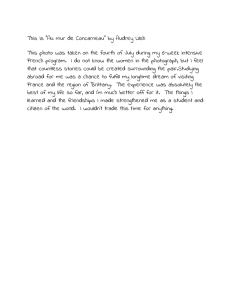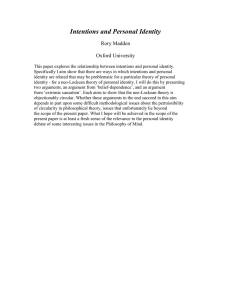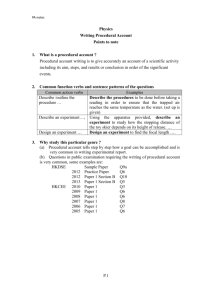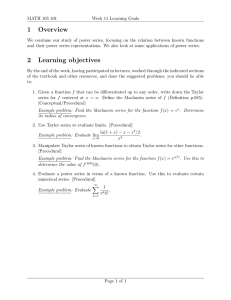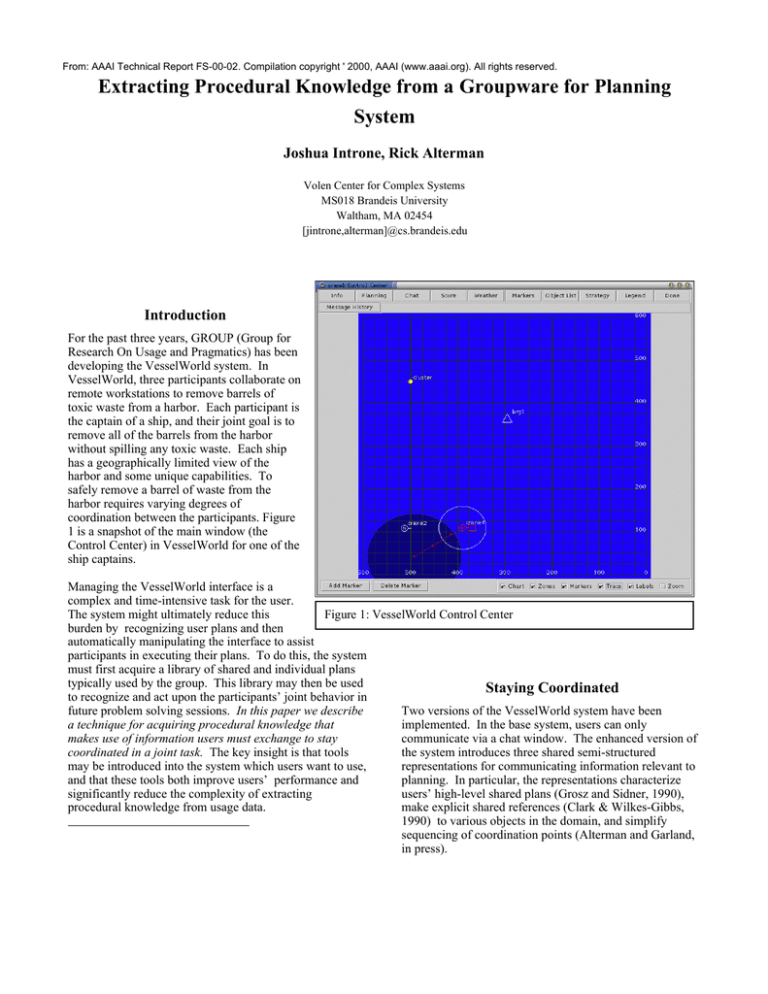
From: AAAI Technical Report FS-00-02. Compilation copyright ' 2000, AAAI (www.aaai.org). All rights reserved.
Extracting Procedural Knowledge from a Groupware for Planning
System
Joshua Introne, Rick Alterman
Volen Center for Complex Systems
MS018 Brandeis University
Waltham, MA 02454
[jintrone,alterman]@cs.brandeis.edu
Introduction
For the past three years, GROUP (Group for
Research On Usage and Pragmatics) has been
developing the VesselWorld system. In
VesselWorld, three participants collaborate on
remote workstations to remove barrels of
toxic waste from a harbor. Each participant is
the captain of a ship, and their joint goal is to
remove all of the barrels from the harbor
without spilling any toxic waste. Each ship
has a geographically limited view of the
harbor and some unique capabilities. To
safely remove a barrel of waste from the
harbor requires varying degrees of
coordination between the participants. Figure
1 is a snapshot of the main window (the
Control Center) in VesselWorld for one of the
ship captains.
Managing the VesselWorld interface is a
complex and time-intensive task for the user.
The system might ultimately reduce this
Figure 1: VesselWorld Control Center
burden by recognizing user plans and then
automatically manipulating the interface to assist
participants in executing their plans. To do this, the system
must first acquire a library of shared and individual plans
typically used by the group. This library may then be used
Staying Coordinated
to recognize and act upon the participants’ joint behavior in
future problem solving sessions. In this paper we describe
Two versions of the VesselWorld system have been
a technique for acquiring procedural knowledge that
implemented. In the base system, users can only
makes use of information users must exchange to stay
communicate via a chat window. The enhanced version of
coordinated in a joint task. The key insight is that tools
the system introduces three shared semi-structured
may be introduced into the system which users want to use,
representations for communicating information relevant to
and that these tools both improve users’ performance and
planning. In particular, the representations characterize
significantly reduce the complexity of extracting
users’ high-level shared plans (Grosz and Sidner, 1990),
procedural knowledge from usage data.
make explicit shared references (Clark & Wilkes-Gibbs,
1990) to various objects in the domain, and simplify
sequencing of coordination points (Alterman and Garland,
in press).
To design the semi-structured representations,
over eighty hours of data from several user
groups using the base VesselWorld system
was collected and analyzed. This analysis
identified several recurring types of
coordination breakdowns, and subsequent
interviews with user groups verified this.
Below is an example of usage data (only the
information extracted from the chat window
is shown here) that demonstrates such a
coordination breakdown. In this dialogue two
ship captains are doing a joint lift and carry,
but do not closely coordinate on entry and
exist phases, and so get out of synch and drop
the barrel of toxic waste (line 7).
1. 10406910 crane2 : I'm at lw4. Any spec. equip?
2. 10460863 crane1 : nonenone
3. 10500140 crane2 : Ok I've deployed the crane and will attach at next move
4. 10518860 crane1 : ok, and lift
5. 10633890 crane2 : let's head over to the barge and dump her. let me know
6. when to dump
7. 10668900 crane2 : I think we dropped it
8. 10701610 crane1 : i know but i don't see you or the waste any more
9. 10762511 crane2 : Move along side it and we will try again
11. 10831340 crane1 : ready to lift?
12. 10853251 crane2 : not yet ihaven't deploy and i'm not close enough to you
13. 10892720 crane2 : I'll tell you when
14. 10965830 crane2 : Ok,c1
15. 11010104 crane2 : Hold on I can't find you
Figure 2: Coordination Failure
The three components which were developed to overcome
coordination difficulties that were identified are the
Strategic Planning window, the Object List, and the
Shared Planning window. Each of these components is
shared, so that the same information is seen by all users in
these components at any given time.
out by clicking on the world interface or object list, or
typed in directly.
Figure 4: The Object List
• The Object List
Figure 3: Strategic Planning
• Strategic Planning
The Strategic Planning window allows participants to
share information about high-level plans and goals. It
consists of three columns side by side, one for each
captain, to allow users to specify current and future
intentions, and indicate relative positioning of these
intentions. Entries in each column may be moved
around, edited, and marked to indicate whether the status
of the item is active, pending, or complete. Six highlevel operators are provided with which to compose
entries in the Strategic Planning window. These
operators were chosen on the basis of chat traces from
preliminary trials, and the close examination of one
expert group. Each operator may be further specified by
filling out supporting fields. These fields may be filled
The Object List helps make references to objects in the
world explicit. Each entry in this list contains several
fields of information including an user assigned name,
the status, and the location of the associated object. The
location field may be filled by clicking on the field and
then upon an object in the world. A free text field is also
provided for each entry so that any other relevant
information may be communicated. Icons representing
objects with valid locations may be displayed in the
Control Center (Figure 1) interface, to assist users in
mapping items in the list to objects in the world.
Figure 5: Shared Planning window
• Shared Planning
The Shared Planning window is a view of the steps each
actor has actually entered for future submission. This is
a modification from the base system, in which a user
may only see his or her own plans. The Shared Planning
window provides a means for close coordination without
explicit communication (for example, in the case where
two users must lift a barrel at the same time), and can
help to make low-level actions explicit where the
strategy window does not provide the appropriate
granularity of information.
Because the Object List and Strategy Component are semistructured, the number of low-level (e.g. keystroke)
actions users must perform to communicate information
these components are designed to handle is reduced, while
the ability to communicate information beyond what has
been anticipated in their design is preserved (Malone et al.,
1986). The structure of these components also serves as a
reminder for participants of information necessary to stay
coordinated. Experiments are currently underway which
will confirm that the semi-structured representations
improve the participants' performance (as determined by
several criteria) over chatting alone.
Segmenting the data
All user activity is logged by the VesselWorld system. The
task for the system is to segment this usage data into goaloriented procedural representations. This is a very difficult
task in the base system for several reasons: interface
actions pertaining to different goals are interleaved, both
for the group and for the individual; interface actions
themselves are not marked in any way to indicate which
goal, if any, an action serves; references to objects in the
chat transcripts vary in format, rely upon contextual
information, and contain frequent mistakes; users do not
announce intentions and plans in the chat traces in any
canonical fashion, and so this information must be
extracted by hand or an NLP system.
The data provided by the semi-structured representations
significantly reduces the complexity of the segmentation
task. The Strategy Component partially segments the data
into regions of goal-directed behavior, providing a hint as
to what goal user actions correspond to. The Object List
establishes canonical references within the system, and
moves much of the object-specific information from
unstructured chat to a structured format which is readily
interpreted by the system. This additional information
helps provide the system with the context necessary to
reliably tease apart many interleaved interface actions into
threads of goal directed activity.
An Example with the Object List
The first step in building a procedural model of user
activity is to sort the usage data into threads of activity
which refer to objects. In the base VesselWorld system,
the only data available to the system for determining what
interface actions refer to which objects are chat traces and
individual plans. Users may refer to objects using a variety
of methods, and discovering these is a difficult task for the
system. With the Object List representation, users tell both
the system and other participants what names reference
which objects. Subsequent communication regarding these
objects via chat, the Strategic Planning window, or Object
List itself, usually makes use of these references, and the
object referred to in such communication can thus be
resolved by the system with minimal effort.
One step in creating entries in the Object List is clicking on
a field in the Object List and then clicking on an object in
the World View. The action of clicking on an item in the
World View generates an event which logs the connection
between the object and a unique identifier used internally
by the system. Users create a name for the object in a free
text field, and update other fields appropriately. Status
information regarding an object is frequently passed
through the supporting fields in an Object List entry rather
than exchanged in chat. Communication about the object in
chat will very likely use the name established in the Object
List. A thread of activity referring to an object in the world
may be identified by reading the usage data with a
modified state machine that collects events which are likely
to refer to a given waste. Figure 6 is a simplified version
of portion of such a state machine. The circled numbers in
the diagram indicate the steps in setting up a container for
the history of activities associated with an object. These
steps are as follows:
1.
2.
3.
The user enters info mode, which is necessary to get
full information about an object, and clicks on an
object in the interface to retrieve that information. The
generated event contains the system’s internal name
for the waste (not available to the user) and a location.
If no existing waste with this name has yet been
discovered, a candidate waste history container is
generated.
The user clicks on a field in the Object List, and then
clicks on the world view to instantiate the Location
field. If this location matches (or is close enough to) a
location in a candidate container for an object history,
the candidate is marked as resolved by the system.
Additional information is added to the resolved object
history container as that user, or other users, modify
fields in that Object List entry.
Nearly all subsequent user-generated events concerning
this object may be identified using the established
references and can be collected into the history container.
Building Procedural Knowledge
After many such activity threads have been extracted, they
will be used to develop a case base for goals in the
VesselWorld environment. The Multicase model (ZitoWolf) is the current best candidate for the case base
architecture. In Multicase, multiple episodes are
represented as a directed network of decision points, which
can enumerate both encountered execution paths and
explicit instructions to achieve a goal. Multicase is ideal
for the task at hand, because it compiles all prior
experience directly into a procedural representation.
Several modifications, however, will need to be made to
Multicase to tailor it to group activity.
Experiment
Figure 6: State Machine
A object history that has been generated by such a state
machine is shown in Figure 7.
The research group is currently collecting data with the
enhanced version of the VesselWorld system.
Approximately forty hours of usage data have been
collected thus far, with a target of over one hundred hours
of data with this system. Half of this data will be used to
train a predictive model in the manner described above,
and the effectiveness of the model will be tested against the
remaining data.
Summary and Future Direction
Collaboration and joint activity require awareness of other
actors’ goals, plans, commitments, and intentions (Grosz &
Kraus, 1996; Bratman, 1999; Levesque, Cohen, and Nunes,
pr000-mwaste1
*************
4364
crane2 pr000-mwaste1 java.awt.Point[x=427,y=55,java.awt.Point[x=183,y=60]
4508
crane2 pr000-mwaste1 {Location=183 60, Size=Medium, Action=Located, Equipment=Unknown, Leak=Not Leaking, Notes=,
Name=mw4}*
4952
tug1 pr000-mwaste1 java.awt.Point[x=428,y=548],
5095
tug1 pr000-mwaste1 {Location=183 60, Size=Medium, Action=Located, Equipment=None, Leak=Not Leaking, Notes=, Name=mw4}
11719
crane1 pr000-mwaste1 I'm going to go do mw4 while we're waiting.
11818
crane1 pr000-mwaste1 {Notes=, Source=, Action=DO, Destination=, Object=mw4,Color=java.awt.Color[r=178,g=0,b=0],
Location=,Agent=Crane1}
13128
crane1 pr000-mwaste1 {Notes=, Source=, Action=DO, Destination=, Object=mw4, Color=java.awt.Color[r=0,g=178,b=0],
Location=, Agent=Crane1}
14151
crane1 pr000-mwaste1 [(LIFT [crane1] {} pr000-mwaste1), (CARRY [crane1] {288 76}), (CARRY[crane1] {334 86}), (CARRY
[crane1] {380 96}), (CARRY [crane1] {426 106}), (CARRY [crane1] {472 116}), (CARRY [crane1] {517 126}), (LOAD [crane1] {}
barge1)]
14468
crane1 pr000-mwaste1 {Location=ih, Size=Medium, Action=Located, Equipment=None, Leak=Not Leaking, Notes=, Name=mw4}
15589
crane1 pr000-mwaste1 I'm heading to the brg with mw4.
17955
crane1 pr000-mwaste1 {Notes=, Source=, Action=DO, Destination=, Object=mw4, Color=java.awt.Color[r=128,g=128,b=128],
Location=, Agent=Crane1}
18171
rane1 pr000-mwaste1 {Location=brg, Size=Medium, Action=Located, Equipment=None, Leak=Not Leaking, Notes=, Name=mw4}
Figure 7: Waste History
1990), so that effective coordination may take place. In
collaborative tasks where there is a separation of time or
space or both, coordination is more difficult because
intentions, plans, goals, references, and coordination
points must be explicitly communicated. Semi-structured
representations facilitate such communication, and, if
properly designed, users will want to use them. These
components also reduce the guesswork in determining
what the users' intentions because the structured
communication is more easily interpreted by the system.
Three interface components have been discussed in this
abstract which make the task of communicating plans and
intentions easier, and structure the information in a useful
fashion. Experiments with these new components are
underway, and we will soon be able to quantitatively
describe to what degree these components actually assist
users, and if the information they provide though structure
is sufficient to build procedural knowledge.
By storing goal-based procedural knowledge in a case base
it will be possible to create a system which reduces the
amount of work users must do to accomplish their goals in
the task domain. Case retrieval and predictions provided
by our representation can be used to support automation of
interface actions, such as moving and resizing windows, or
highlighting of important information. Cases might
ultimately be retrieved to offload some of the work in
planning. Tracking breakdowns in coordination with
respect to user intentions will indicate areas where
procedural knowledge may be reintroduced to assist
novices. Because usage data has been obtained in
conjunction with a reliable representation of user intentions
and goals, reconstruction of domain specific procedural
knowledge and the effective reapplication of this
knowledge to assist users will be possible.
References
Alterman, R. and Garland, A. (2000) Convention in joint
activity. Cognitive Science, To Appear.
Alterman, R. (2000) Rethinking Autonomy. Minds and
Machines, 10:1 15-30.
Alterman, R., Landsman, S., Feinman, A., Introne, J., and
Kirchenbaum, S. (1998) Groupware for Planning,
Brandeis University Computer Science Department,
Technical Report CS-98-200.
Bratman, M. E. (1999) Shared cooperative activity. In
Faces of Intention, pp. 93-108. Cambridge University
Press, 1999.
Clark, H. H. and Wilkes-Gibbs, D. (1990). Referring as a
collaborative process. Cognition, 22:1-39.
Grosz, B. and Kraus, S. (1996). Collaborative plans for
complex group action. Artificial Intelligence, 86:269-357.
Grosz, B. and Sidner, C. (1990). Plans for discourse. In
Cohen, P. R., Morgan, J., and Pollack, M. E., editors,
Intentions in Communication, pp. 417-444. Bradford
Books, Cambridge, MA.
Levesque, H. J., Cohen, P. R., and Nunes, J. H. T. (1990).
On acting together. In Proceedings of the Eighth National
Conference on Artificial Intelligence, pp. 94-99.
Malone, T. W., Grant, K. R., Lai, K., Rao, R., Rosenblitt,
D. (1986) In Proceeding of the Conference of ComputerSupported Coorperative Work.
Zito-Wolf, R. J., (1993). Case-Based Representations for
Procedural Knowledge. Ph.D. thesis, Brandeis University.


